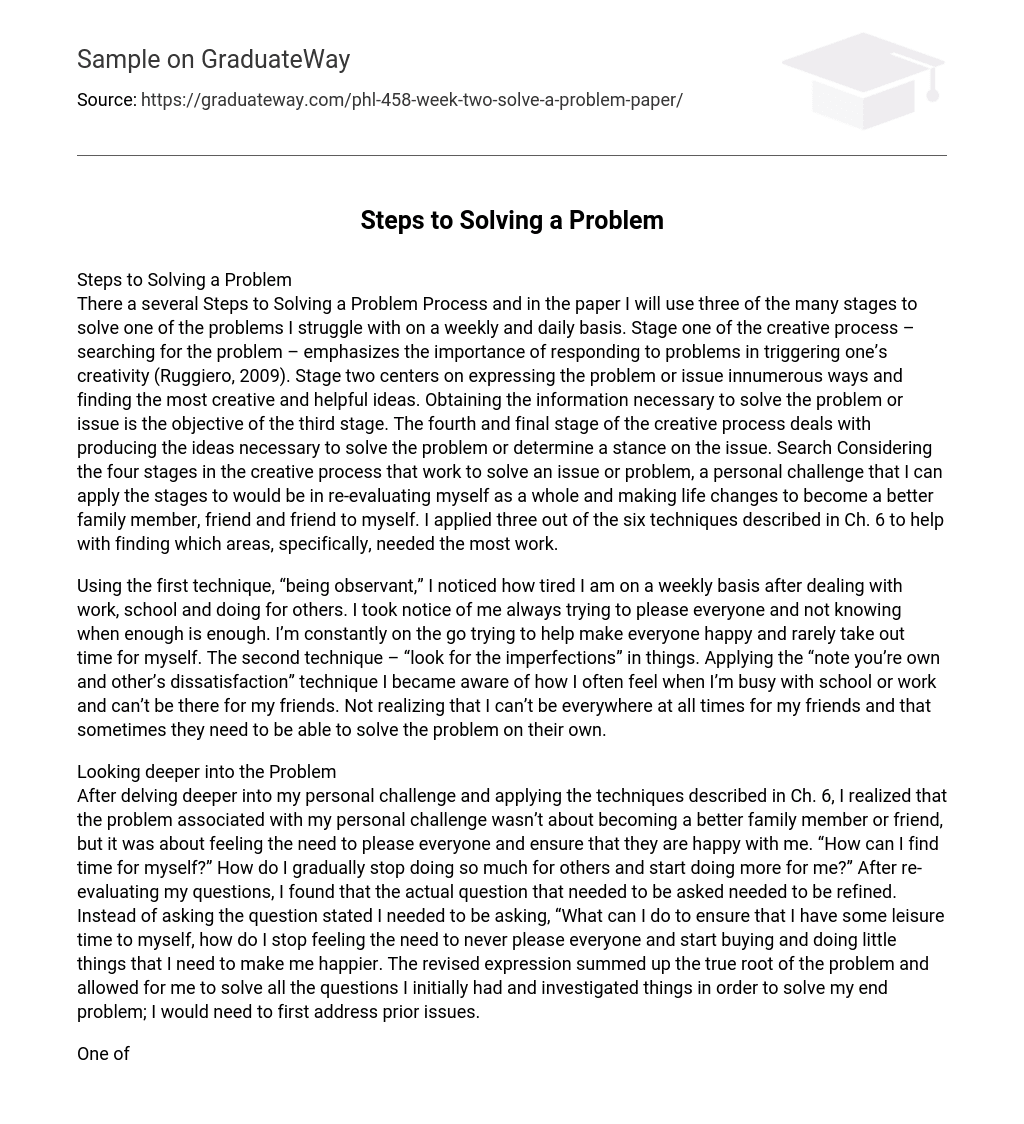Steps to Solving a Problem
In this paper, I will examine the Steps to Solving a Problem Process and emphasize three particular stages for addressing a problem that I often encounter. The initial stage of the creative process involves seeking out the problem, emphasizing the importance of addressing problems to foster creativity (Ruggiero, 2009).
Stage two concentrates on showcasing the problem or issue in various manners and generating the most inventive and beneficial ideas. The main goal of stage three is to collect pertinent information to tackle the problem or issue. The fourth and ultimate stage of the creative process involves producing ideas that are essential for discovering a solution to the problem or establishing a stance on the issue.
Through the utilization of the four stages of the creative process, I can work towards enhancing myself as a family member, friend, and individual. Throughout this process, I implemented three out of the six techniques from Chapter 6 to determine the areas that required the most improvement.
By carefully observing, I have noticed my chronic tiredness caused by the demands of work, school, and caregiving responsibilities. It is clear that I constantly strive to please everyone around me without realizing the need for a break. Continuously pursuing various obligations unknowingly neglects my own well-being. Additionally, another approach involves recognizing flaws. By acknowledging both my own and others’ dissatisfaction, it became evident how often I feel overwhelmed when unable to support my friends due to academic or professional commitments. This realization has made me understand that I can’t always be readily available for them and that sometimes they must find solutions on their own.
Looking deeper into the Problem
Upon further examination of my personal challenge and implementing the strategies discussed in Chapter 6, I came to the understanding that the issue linked to my personal challenge was not centered around improving my role as a family member or friend. Instead, it revolved around the constant urge to satisfy everyone and guarantee their contentment with me. The questions that emerged were, “How can I allocate time for myself?” and “How can I gradually shift my focus from doing excessive favors for others to prioritizing myself?” Upon reassessing these inquiries, I realized the necessity of refining the actual question to be posed.
Instead of fixating on the initial inquiry, I should have inquired about managing leisure time and alleviating the perpetual pressure to satisfy everyone. Additionally, it was imperative for me to prioritize my own needs and derive joy from simple pleasures. This fresh outlook aided me in recognizing the root problem and resolving all my original worries. To tackle my ultimate dilemma, I comprehended the necessity of addressing past conflicts initially.
One of my concerns was finding time for myself. After calculating the amount of time I spend at work, school, with my son, and with my friends, it became clear that I usually only have one or two hours during the week for personal time. This reflection reminded me of a period when I was frequently deployed and unable to spend quality time with my son and friends. Currently, I understand that everyone is happy to see me settled in one place and we all want to make the most of our time together. However, it is still difficult to find enough time for each person as well as for myself. To address this issue, I need to create a schedule and stick to it while also being honest about feeling overwhelmed or needing alone time.
Conclusion
The main issue I encountered during my personal challenge was how to ensure that I expressed love and gratitude to my family members without feeling the need to constantly please them. Through research, I gained a better understanding of their true desires and needs. In conclusion, I learned that maintaining a calendar to allocate specific days for bonding with loved ones, setting aside personal time each week, and dedicating a day every two weeks or twice a month for self-care would help address this issue.
Through investigation, I discovered that I could improve my time management and address the needs of my family and friends more effectively by spreading out my attention over a few days. This approach allows me to make everyone happy, including myself. Additionally, I have set aside a specific day each month for a special “mom and son” night. During this time, my son and I choose a movie or engage in a fun activity together. Moreover, I have started dedicating more time to sending out weekly text messages conveying my love or letting them know that they are in my thoughts. I also inform them if my work or school schedule is busy, which may limit our hangouts for that particular week or month.
Having the ability to communicate directly and not feeling guilty about needing alone time to complete work tasks or school assignments will make me a more well-rounded friend and family member, ultimately alleviating the stress I used to experience when I struggled to express my need for boundaries.
Reference
- Teacher Scholastic: http://teacher.scholastic.com/lessonrepro/lessonplans/steppro.htm Ruggiero, V. R. (2009). The art of thinking: A guide to critical and creative thought (9th ed.). New York, NY: Pearson Longman.





